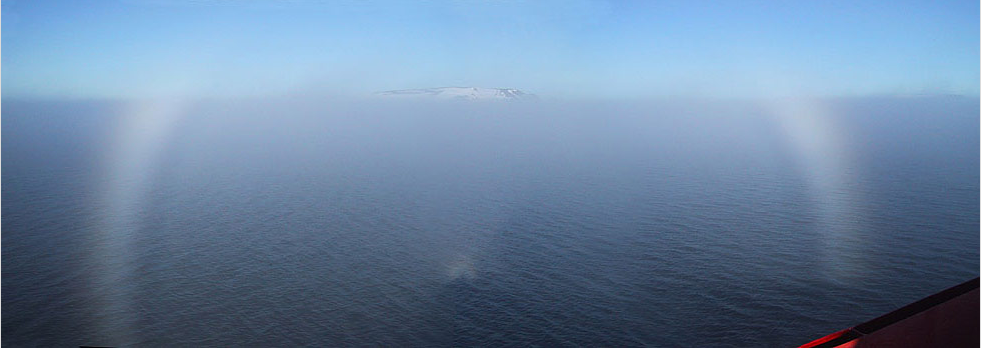Arctic fogbow
Arctic Fogbow: A Mystical Phenomenon in the Icy Wilderness
Have you ever heard of an Arctic fogbow? This captivating atmospheric phenomenon is a rare sight to behold in the remote and frigid regions of the Arctic Ocean. While fogbows are similar to rainbows, they occur in foggy conditions rather than during rainfall. In this article, we will delve into the enchanting world of Arctic fogbows, exploring their formation, unique characteristics, and the magical experience of witnessing one.
The Formation of Arctic Fogbows
Arctic fogbows are formed when sunlight interacts with tiny water droplets suspended in the air, creating a stunning optical display. When light passes through these droplets, it undergoes refraction and reflection, resulting in the formation of a bow-shaped arc. However, unlike rainbows, fogbows lack the vibrant colors we associate with their more well-known counterparts.
The Subtle Beauty of Arctic Fogbows
The ethereal beauty of Arctic fogbows lies in their delicacy and subtlety. Unlike rainbows, which boast a vivid spectrum of colors, fogbows appear as pale, ghostly arcs against the backdrop of the foggy landscape. These arcs often have a faint bluish or white hue, adding to their mystique. Inside the main arc, lucky observers may even catch a glimpse of a faint supernumerary, a series of additional bands of color caused by interference between light waves.
The Role of Fog in Creating Arctic Fogbows
Fog is a crucial element in the formation of Arctic fogbows. As cold air meets the relatively warmer waters of the Arctic Ocean, moisture evaporates and rises, creating a thick blanket of fog. The tiny water droplets within the fog act as prisms, bending and scattering sunlight to create the atmospheric conditions necessary for a fogbow to materialize.
The Challenging Quest to Witness an Arctic Fogbow
Encountering an Arctic fogbow is a rare and elusive experience. The remote locations where these phenomena occur, coupled with the unpredictable and ever-changing nature of fog, make them a true spectacle to witness. Adventurers who brave the harsh conditions of the Arctic may be rewarded with the sight of a fogbow, as if nature itself were unveiling its most enchanting secrets.
The Antisolar Point and the Glory Effect
One fascinating aspect of Arctic fogbows is the presence of the antisolar point, also known as the photographer's shadow. This is the point directly opposite the sun where the observer's shadow is cast. When sunlight interacts with the tiny water droplets in the fog, it creates a phenomenon called a glory. The glory appears as a radiant halo around the antisolar point, adding an extra touch of wonder to the already mesmerizing scene.
The Influence of Ice Crystals on Arctic Fogbows
While water droplets play a crucial role in the formation of fogbows, ice crystals can also contribute to their appearance in Arctic regions. As temperatures plummet in the frigid Arctic environment, water droplets can freeze, transforming into ice crystals suspended in the air. These ice crystals can interact with sunlight in a similar manner to water droplets, creating a breathtaking display of an Arctic fogbow.
The Enigmatic Appeal of Arctic Fogbows
Arctic fogbows hold a unique allure due to their rarity and the remote locations where they manifest. They offer a glimpse into the captivating wonders of our atmosphere and remind us of the intricate interplay between light and water in creating natural spectacles. Witnessing an Arctic fogbow is like stepping into a dream, where reality merges with magic, leaving observers in awe of the natural world's endless surprises.
In conclusion, Arctic fogbows are a mesmerizing atmospheric phenomenon that enchants those lucky enough to witness them. With their subtle beauty, delicate arcs, and supernatural presence, fogbows bring a touch of enchantment to the icy wilderness of the Arctic. Although elusive, these ethereal displays serve as a reminder of the infinite wonders that await us in the natural world. So, if you ever find yourself in the Arctic, keep your eyes peeled for the elusive Arctic fogbow, and let yourself be captivated by its mystical charm.

Midway along the Franz Josef Archipelago in the Arctic Ocean. Ann Bowker took this panorama on 15th July 2002 from high on the stern of an icebreaker. The fog clings close to the cold ocean. The fogbow is slightly coloured and inside the main arc there is a faint supernumerary. The shadow of the vessel is faintly visible and the photographer's shadow - the antisolar point - is lit by a glory. Another Arctic fogbow image. ©2002 Ann Bowker, shown with permission.
Note: this article has been automatically converted from the old site and may not appear as intended. You can find the original article here.
Reference Atmospheric Optics
If you use any of the definitions, information, or data presented on Atmospheric Optics, please copy the link or reference below to properly credit us as the reference source. Thank you!
-
<a href="https://atoptics.co.uk/blog/arctic-fogbow-2/">Arctic fogbow</a>
-
"Arctic fogbow". Atmospheric Optics. Accessed on November 26, 2024. https://atoptics.co.uk/blog/arctic-fogbow-2/.
-
"Arctic fogbow". Atmospheric Optics, https://atoptics.co.uk/blog/arctic-fogbow-2/. Accessed 26 November, 2024
-
Arctic fogbow. Atmospheric Optics. Retrieved from https://atoptics.co.uk/blog/arctic-fogbow-2/.